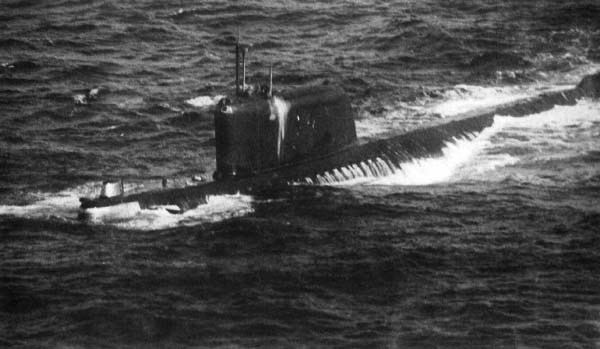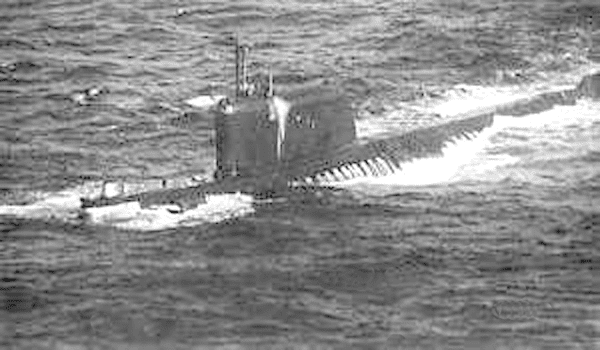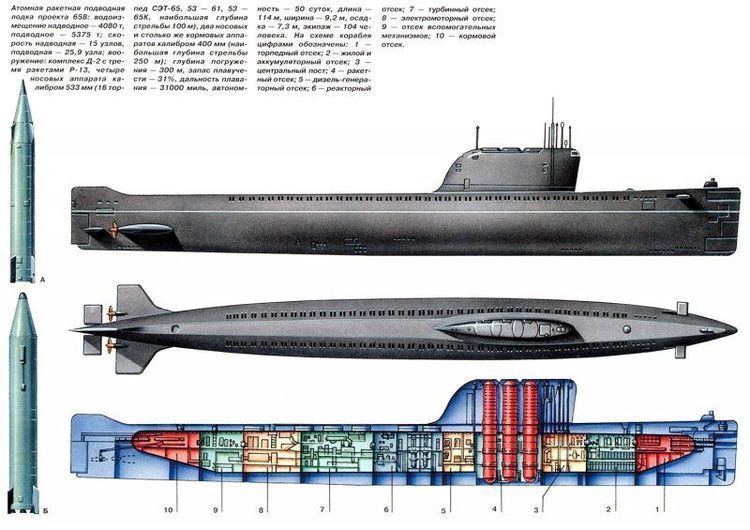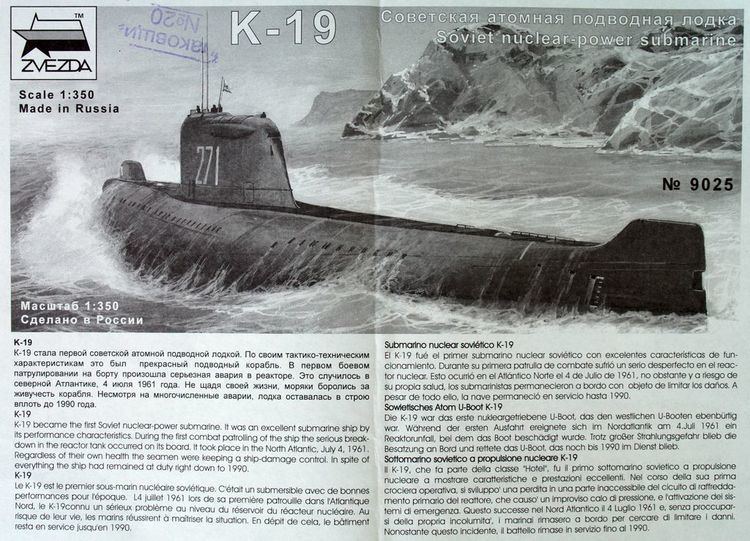Name K-19 Completed 12 November 1960 Decommissioned 19 April 1990 Length 114 m Launched 8 April 1959 | Laid down 17 October 1958 Commissioned 30 April 1961 Construction started 17 October 1958 Beam 9.2 m | |
 | ||
Reactor accident on Soviet Submarine K-19
K-19 was one of the first two Soviet submarines of the 658 class (NATO reporting name Hotel-class submarine), the first generation nuclear submarine equipped with nuclear ballistic missiles, specifically the R-13 SLBM. The boat was hurriedly built by the Soviets, who were anxious to catch up with the United States' lead in nuclear submarines. Before it was launched, 10 civilian workers and a sailor died due to accidents and fires. After it was commissioned, it was plagued with breakdowns and accidents, several of which threatened to sink the sub.
Contents
- Reactor accident on Soviet Submarine K 19
- Background
- Construction deaths
- Gains unlucky reputation
- Early problems
- Nuclear accident
- Deceased crew members
- Crew members decorated
- Later operational history
- Collision
- Fires
- Reclassification
- Decommissioning
- Theatre and film
- References

On its initial voyage on 4 July 1961, it suffered a complete loss of coolant to its reactor. With no backup system, the captain ordered members of the engineering crew to find a solution to avoid a nuclear meltdown. Sacrificing their own lives, the engineering crew jury-rigged a secondary coolant system and kept the reactor from a meltdown. Twenty-two crew members died from radiation sickness during the following two years. The sub experienced several other accidents, including two fires and a collision. The series of accidents inspired crew members to nickname the sub Hiroshima.

Background

In the late 1950s, the leaders of the Soviet Union were determined to catch up with the United States and began to build a nuclear sub fleet, pushing subs through production and testing so rapidly that many Russian naval officers felt that the ships were not fit for combat. The crew aboard the first nuclear submarines of the Soviet fleet was provided with a very high quality standard of food including smoked fish, sausages, fine chocolates and cheeses, unlike the standard fare given the crews of other naval vessels.
Construction deaths

K-19 was ordered by the Soviet Navy on 16 October 1957. Her keel was laid on 17 October 1958 at the naval yard in Severodvinsk. Several workers died building the submarine: two workers were killed when a fire broke out, and later six women gluing rubber lining to a water cistern were killed by fumes. While missiles were being loaded, an electrician was crushed to death by a missile-tube cover, and an engineer fell between two compartments and died.
Gains unlucky reputation

The ship was launched and christened on 8 April 1959. Breaking with tradition, a man—Captain 3rd Rank V. V. Panov of the 5th Urgent Unit—instead of a woman, was chosen to smash the ceremonial champagne bottle across the ship's stern. The bottle failed to break, instead sliding along the screws and bouncing off the rubber-coated hull. This is traditionally viewed among sea crews as a sign that the ship is unlucky. Captain 1st Rank Nikolai Vladimirovich Zateyev was the first commander of the submarine.
Early problems
In January 1960, confusion among the crew during a watch change led to improper operation of the reactor and a reactor-control rod was bent. The damage required the reactor to be dismantled for repairs. The officers on duty were removed and Captain Panov was demoted.
The submarine's ensign was hoisted for the first time on 12 July 1960. It underwent sea trials from 13 through 17 July 1960 and again from 12 August through 8 November 1960, transiting 17,347 kilometres (10,779 mi). The ship was considered completed on 12 November 1960. After surfacing from a full-power run, the crew discovered that most of the hull's rubber coating had detached, and the entire surface of the boat had to be re-coated.
During a test dive to the maximum depth of 300 m (980 ft), flooding was reported in the reactor compartment, and Captain Zateyev ordered the sub to immediately surface, where it keeled over on its port side due to the water it had taken on. It was later determined that during construction the workers had failed to replace a gasket. In October, 1960, the galley crew disposed of wood from equipment crates through the galley's waste system, clogging it. This led to flooding of the ninth compartment, which filled one third full of water. In December 1960, a loss of coolant caused failure of the main circuit pump. Specialists called from Severodvinsk managed to repair it at sea within a week.
The boat was commissioned on 30 April 1961. The sub had a total of 139 men aboard, including missile men, reactor officers, torpedo men, doctors, cooks, stewards, and several observing officers who were not part of the standard crew.
Nuclear accident
On 4 July 1961, under the command of Captain First Rank Nikolai Vladimirovich Zateyev, K-19 was conducting exercises in the North Atlantic close to Southern Greenland when it developed a major leak in its reactor coolant system, causing the water pressure in the aft reactor to drop to zero and causing failure of the coolant pumps. A separate accident had disabled the long-range radio system, so they could not contact Moscow. Despite the control rods being inserted via a SCRAM mechanism, the reactor temperature rose uncontrollably due to decay heat from fission products created during normal operation, eventually reaching 800 °C (1,470 °F). The reactor continued to heat up as the required coolant was not available during shutdown because of design shortcomings which did not include a backup cooling system.
Making a drastic decision, Zateyev ordered the engineering section to fabricate a new coolant system by cutting off an air vent valve and welding a water-supplying pipe into it. This required the men to work in high radiation for extended periods. The accident released radioactive steam containing fission products which were drawn into the ship's ventilation system and spread to other compartments of the ship. The jury-rigged cooling water system successfully reduced the temperature in the reactor.
The incident irradiated the entire crew, most of the ship, and some of the ballistic missiles on board. All seven members of the engineering crew and their divisional officer died of radiation exposure within the next month. Fifteen more sailors died from the after-effects of radiation exposure within the next two years.
Instead of continuing on the mission's planned route, the captain decided to head south to meet diesel-powered submarines expected to be there. Worries about a potential crew mutiny prompted Zateyev to have all small arms thrown overboard except for five pistols distributed to his most trusted officers. A diesel submarine, S-270, picked up K-19's low-power distress transmissions and joined up with it.
American warships nearby had also heard the transmission and offered to help, but Zateyev, afraid of giving away Soviet military secrets to the West, refused and sailed to meet the S-270. He evacuated the crew and had the boat towed to its home base. After its return to port, the vessel contaminated a zone within 700 m (2,300 ft). Over the next two years, repair crews removed and replaced the damaged reactors. The repair process contaminated the nearby environment and the repair crew. The Soviet Navy dumped the original radioactive compartment into the Kara Sea.
According to the government's official explanation of the disaster, the repair crews discovered that the catastrophe had been caused by a faulty welding incident during initial construction. They discovered that during installation of the primary cooling system piping, a welder had failed to cover exposed pipe surfaces with asbestos drop cloths (required to protect piping systems from accidental exposure to welding sparks), due to the cramped working space. A drop from a welding electrode fell on an unprotected surface, producing an invisible crack. This crack was subject to prolonged and intensive pressure (over 200 atmospheres), compromising the pipe's integrity and finally causing it to fail.
Others disputed this conclusion. Retired Rear-Admiral Nikolai Mormul asserted that when the reactor was first started ashore, the construction crew had not attached a pressure gauge to the primary cooling circuit. Before anyone realized there was a problem, the cooling pipes were subjected to a pressure of 400 atmospheres, double the acceptable limit. K-19 returned to the fleet with the nickname "Hiroshima".
On 1 February 2006, former President of the Soviet Union Mikhail Gorbachev proposed in a letter to the Norwegian Nobel Committee that the crew of K-19 be nominated for a Nobel Peace Prize for their actions on 4 July 1961.
Deceased crew members
Several crew members received fatal doses of radiation during repairs on the reserve coolant system of Reactor #8. All of them died between one and three weeks after the accident from severe radiation sickness. A person who receives a dose of 4 to 5 Sv (about 400-500 rem) over a short period has a 50% chance of dying within 30 days.
Many other crew members also received doses of radiation exceeding permissible levels. They underwent medical treatment during the following year. The treatment was devised by Professor Z. Volynskiy and included bone marrow transplantation and blood transfusion. It saved, among others, Chief Lieutenant Mikhail Krasichkov and Captain 3rd class Vladimir Yenin, who had received doses of radiation that were otherwise considered deadly. For reasons of secrecy, the official diagnosis was not "radiation sickness" but "astheno-vegetative syndrome" which is a kind of mental disorder.
Crew members decorated
On 6 August 1961, 26 members of the crew were decorated for courage and valor shown during the accident.
Later operational history
On 14 December 1961, the boat was fully upgraded to the Hotel II (658м) variant, which included upgrading to R-21 missiles, which had twice the effective range of the earlier missiles.
Collision
At 07:13 on 15 November 1969, K-19 collided with the attack submarine USS Gato in the Barents Sea at a depth of 60 m (200 ft). It was able to surface using an emergency main ballast tank blow. The impact completely destroyed the bow sonar systems and mangled the covers of the forward torpedo tubes. K-19 was able to return to port where she was repaired and returned to the fleet. Gato was relatively undamaged and continued her patrol.
Fires
On 24 February 1972, a fire broke out while the submarine was at a depth of 120 m (390 ft), some 1,300 km (700 nmi; 810 mi) from Newfoundland, in Canada. The boat surfaced and the crew was evacuated to surface warships except for 12 men trapped in the aft torpedo room. Towing was delayed by a gale, and rescuers could not reach the aft torpedo room because of conditions in the engine room. The fire killed 28 sailors aboard the K-19 and two others who died after they were transferred to rescue ships. Investigators determined that the fire was caused by hydraulic fluid leak onto a hot filter.
The boat was finally towed to Severomorsk on 4 April, and the men were rescued after surviving 24 days in the lightless, heatless torpedo room. The rescue operation lasted more than 40 days and involved over 30 ships. From 15 June through 5 November 1972, K-19 was repaired and put back into service.
On 15 November 1972, another fire broke out in compartment 6, but it was put out by the chemical fire-extinguisher system and there were no casualties.
Reclassification
On 25 July 1977, K-19 was reclassified as a Large Submarine, and on 26 July 1979, she was reclassified as a communications submarine and given the symbol KS-19 (КС-19). On 15 August 1982, an electrical short circuit resulted in severe burns to two sailors, and sailor V. A. Kravchuk died five days later.
On 28 November 1985, the ship was upgraded to the 658s (658с) variant.
Decommissioning
On 19 April 1990 the submarine was decommissioned, and was transferred in 1994 to the naval repair yard at Polyarny. In March 2002, it was towed to the Nerpa Shipyard, Snezhnogorsk, Murmansk, to be scrapped. Over its service life, it transited 534,940 km (332,396 mi) during 20,223 operational hours.
In 2006, a section of K-19 was purchased by Vladimir Romanov, who once served on the sub as a conscript, with the intention of "Turning it into a Moscow-based meeting place to build links between submarine veterans from Russia and other countries." So far, the plans remain on hold, and many of K-19's survivors have objected to them.
Theatre and film
In the year 1969 the poet Vasily Aksyonov created his version of the play about the nuclear incident. This critical version is one of the few known works of unofficial literature in the former Soviet Union.
The movie K-19: The Widowmaker (2002), starring Harrison Ford and Liam Neeson, is based on the story of the K-19's first disaster. The production company attempted in March 2002 to secure access to the boat as a set for its production, but the Russian Navy declined. The nickname "The Widowmaker" referred to by the movie was fiction. The submarine did not gain a nickname until the nuclear accident on 4 July 1961, when she was called "Hiroshima".
